Oct 25, 2021
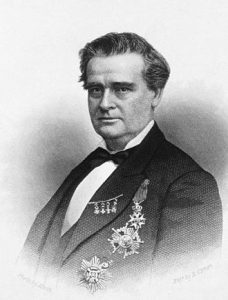 The Woman’s Hospital, often considered the first hospital in this country dedicated to treating the diseases of women, opened on May 4, 1855 in a house on Madison Avenue. It was founded by the currently controversial J. Marion Sims, MD, pictured right, in concert with a group of influential New York City women. Sims arrived in New York in 1853 from his home in Alabama, where he developed a procedure to close vesicovaginal fistulas. He relocated to New York in hopes of improving his own chronic health condition.
The Woman’s Hospital, often considered the first hospital in this country dedicated to treating the diseases of women, opened on May 4, 1855 in a house on Madison Avenue. It was founded by the currently controversial J. Marion Sims, MD, pictured right, in concert with a group of influential New York City women. Sims arrived in New York in 1853 from his home in Alabama, where he developed a procedure to close vesicovaginal fistulas. He relocated to New York in hopes of improving his own chronic health condition.
At first, Sims was welcomed into the medical community of New York and invited to demonstrate his fistula procedure. Unfortunately, once local doctors learned the procedure, they lost interest in him. Sims was unable to establish a strong practice or find a hospital that would offer him operating privileges.
The wife of one of Sims’ few medical friends in the city offered to gather a group of interested and influential women to discuss the state of women’s health care in the city. Thirty-Five women met on February 6, 1855, the outcome of which was the establishment of the Woman’s Hospital Association. The group would move to establish and direct a hospital devoted to the reception and cure of women suffering from “diseases peculiar to their sex.” The Association set up a Board of Managers, referred to as the ‘Board of Lady Managers,’ comprised of thirty-five women, to guide the Hospital. An Executive Committee of seven women, appointed by the Board of Managers, managed the day-to-day affairs of the institution.
In 1857 the Hospital was re-incorporated by the New York State Legislature as the Woman’s Hospital in the State of New York, and re-organized under an all-male Board of Governors. The twenty-seven Governors were responsible for the overall concerns of the Hospital, including filling vacancies of non-female staff, enacting the By-Laws and organizing the Medical Department. Women, however, were still very much in charge of running the Hospital. The former Board of Lady Managers became the Board of Lady Supervisors, and managed the operations of the Hospital, including the appointment of nurses and other female attendants. A smaller Board of Lady Managers remained responsible for handling the day-to-day business of the Hospital. By 1887, the Board of Governors invited four women from the Board of Lady Supervisors to join them. They found this integration “to be most acceptable in its results,” and soon after the Board of Governors was reorganized and evenly divided between men and women.
 As mentioned above, the first Woman’s Hospital was a rented four-story brownstone at 83 Madison Avenue, off 29th Street, pictured left. The brownstone held forty beds and welcomed its first patient in May of 1855. The response to the Hospital’s opening was so great, by fall of 1855 that another surgeon, Thomas Addis Emmet, joined Dr. Sims as the second surgeon on staff. It wasn’t long before the Woman’s Hospital Board was seeking larger accommodations to meet patient demand.
As mentioned above, the first Woman’s Hospital was a rented four-story brownstone at 83 Madison Avenue, off 29th Street, pictured left. The brownstone held forty beds and welcomed its first patient in May of 1855. The response to the Hospital’s opening was so great, by fall of 1855 that another surgeon, Thomas Addis Emmet, joined Dr. Sims as the second surgeon on staff. It wasn’t long before the Woman’s Hospital Board was seeking larger accommodations to meet patient demand.
In 1858, approving the petition of Dr. Sims, the City of New York offered the entire block bounded by 49th and 50th Streets between Lexington and Park Avenues as a site for a new, larger hospital. Originally a Potter’s Field, or Stranger’s Burial Place, the plot was filled with coffins; more than 35,000 of them had to be removed. The first building, the Wetmore Pavilion, opened in 1867 and held seventy-five beds. A matching building, the Baldwin Pavilion, added in 1877, doubled that number. A Mr. Baldwin, who wished to remain anonymous, funded the construction of the second pavilion, contributing $84,000, provided the Association raised the balance of $50,000 to complete it.
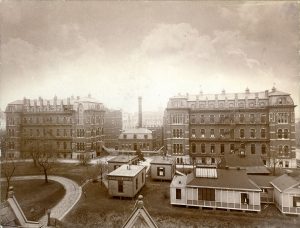 Over the years, the Board recognized the need to develop additional services. A post-graduate school of nursing admitted its first class in 1888. The establishment of a hospital pharmacy in 1881, a maternity ward in 1910, and a social services department in 1912 are examples of the additional services made available at Woman’s Hospital.
Over the years, the Board recognized the need to develop additional services. A post-graduate school of nursing admitted its first class in 1888. The establishment of a hospital pharmacy in 1881, a maternity ward in 1910, and a social services department in 1912 are examples of the additional services made available at Woman’s Hospital.
The 49th Street location proved to be an unsatisfactory one, as the ground tended to be wet, and the basement and ground floors had leaks and dampness. In 1902, all hospital services, except the Out-Patient Clinic, were suspended and the facility was sold. (On a side note, the Waldorf-Astoria Hotel opened on this same plot in 1931.)
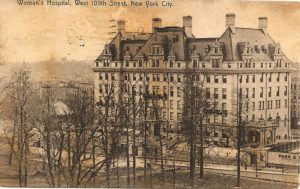 Hospital services resumed in 1906, when a newly constructed Woman’s Hospital opened on West 109th Street, between Amsterdam and Columbus Avenues, pictured left. The hospital functioned here until 1965, when it moved just a few blocks north into a newly constructed building on the St. Luke’s Hospital campus at Amsterdam Avenue at 114th Street, pictured right.
Hospital services resumed in 1906, when a newly constructed Woman’s Hospital opened on West 109th Street, between Amsterdam and Columbus Avenues, pictured left. The hospital functioned here until 1965, when it moved just a few blocks north into a newly constructed building on the St. Luke’s Hospital campus at Amsterdam Avenue at 114th Street, pictured right.
In 1952, realizing that their histories and ideals were parallel, and that it would be beneficial to each to consolidate their resources, which would also strengthen medical services offered to the broader Morningside Heights community, the Board of Trustees of St. Luke’s and Woman’s Hospitals decided to merge.
On January 1, 1953, the Woman’s Hospital became the Woman’s Hospital Division of St. Luke’s Hospital. The Board added “Center” to the Hospital’s name in the mid-1960s to acknowledge distinctions between the different Hospitals. The Woman’s Hospital Board of Governors merged with the corresponding board at St. Luke’s, but the Ladies Associate Board, which handled day-to-day business of the Hospital, continued to meet for some years.
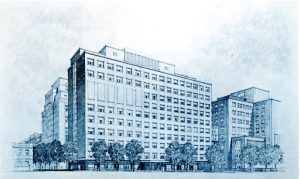
Architect’s drawing of Woman’s Hospital Division
In 1979, St. Luke’s Hospital Center merged with the Roosevelt Hospital forming St. Luke’s-Roosevelt Hospital Center. In 1997, the Hospital Center joined with Beth Israel Medical Center under the Continuum Health Partners banner. In 2013, the Continuum Health Partners merged with Mount Sinai Medical Center forming the Mount Sinai Heath System. The Woman’s Hospital Division on St. Luke’s Hospital campus continued as such for a few years, but eventually duplicated services throughout the combined System. Services re-located, former names were changed, and Woman’s Hospital was consigned to history.
The Woman’s Hospital finding aid is available online here.
Feb 16, 2021
Each January the Aufses Archives starts the New Year by installing a new exhibit highlighting events at Mount Sinai that are reaching a milestone anniversary. In 2021, that includes the celebration of the 175th anniversary of the founding of St. Luke’s Hospital (today’s Mount Sinai Morningside) and the 150th anniversary of the opening of Roosevelt Hospital (today’s Mount Sinai West). The Archives’ staff uses images and original documents to illustrate the most important events, and tries to stick to ‘round number’ anniversaries, e.g. the 25th, 50th, 100th, etc.
Sadly, each year, that leaves us with a group of interesting milestones that are celebrating a ‘not quite a big year.’ Here are a few of those ‘misfit’ milestones for 2021.
1856 – 165 Years Ago
In its first full year of operation, The Jews’ Hospital, later The Mount Sinai Hospital, admitted 216 patients with 129 cured and 14 deaths. Of the 216 admissions, 16 were pay, 200 free. There were two births. The first baby born at the Hospital was called Isaac Touro, in honor of a bequest to the Hospital from him. The patient census varied from a low of 9 to a high of 28. The budget for the year was $5493.76. There were nine paid staff members: two doctors, a Superintendent, nurses, cooks, and domestics.

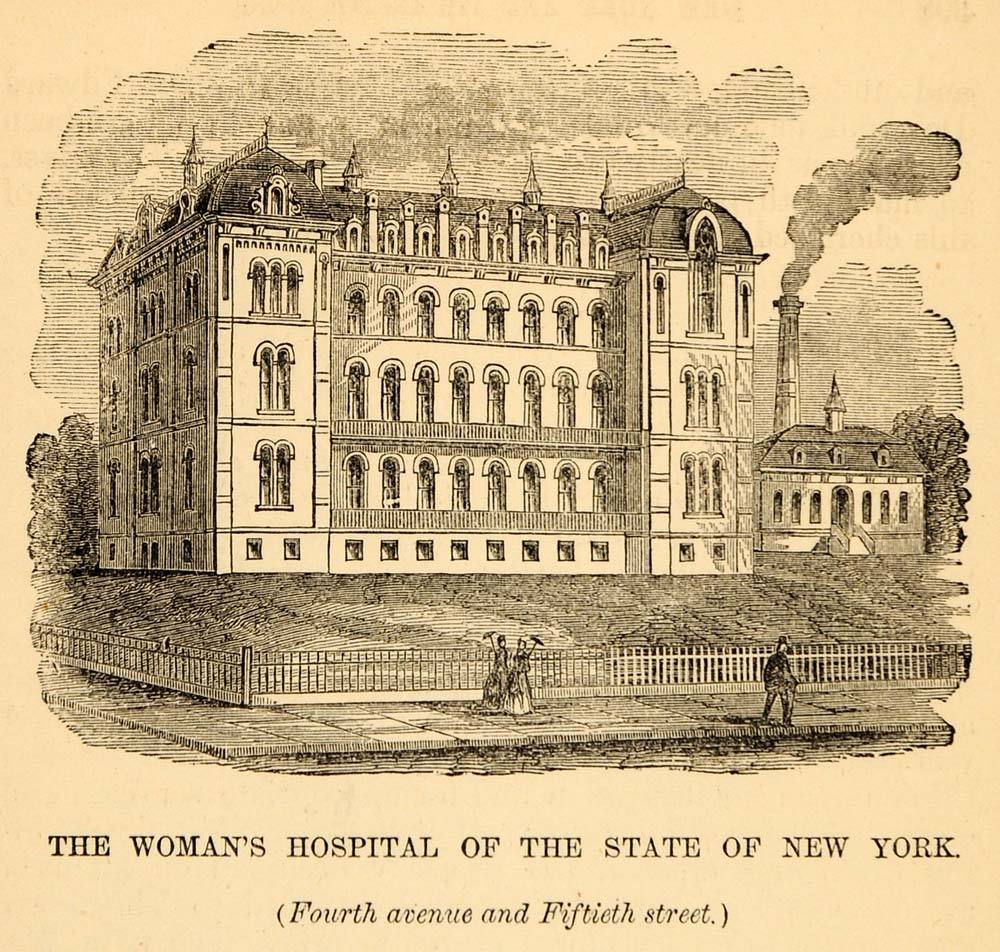
1866 – 155 Years Ago
May 23: the corner stone was laid for a new building between Lexington and Fourth Avenues and 49th and 50th Streets to house the Woman’s Hospital in the State of New York, an institution that would later merge with St. Luke’s Hospital. The City of New York had conveyed the deed to this block to the hospital in 1857. It had been a Potter’s field or Stranger’s Burial Place and filled with coffins. It was noted that more than 35,000 had to be removed before the hospital could be built.
1871 – 155 Years Ago:
On July 12, The Mount Sinai Hospital cared for 25 people injured in the nearby Boyne Day riot, which saw Ulster Scots Protestants holding a parade, protected by NYC Police and State National Guardsmen, with Irish Catholic laborers protesting the celebration. Over 60 people died and more than 150 people were wounded, including 22 militiamen, 20 policemen injured by thrown missiles, and four who were shot, but not fatally.
1881 – 140 Years Ago
William Halsted, MD, organizes an outpatient ‘dispensary’ (Out Patient Dept.) in the basement of the main Admin building at Roosevelt Hospital and remains its director until 1886.
1891 – 120 Years Ago
May 10: Beth Israel Hospital moves to 196 Broadway. This is the first BI location to include inpatient beds in addition to an outpatient dispensary; there are twenty beds. The hospital includes two house staff to provide 24 hour care.
1906 – 115 Years Ago

Beth Israel’s Dazian Pavilion in the 1930s
The Beth Israel Hospital Social Service Dept. is created.
1936 – 85 Years Ago
A Department of Hematology established at the Beth Israel Hospital under the direction of Dr. Louis Greenwald.
1946 – 75 years ago:
The Mount Sinai Hospital opened the first lab in this country dedicated solely to pancreatic disease research; led by Drs. David Dreiling and Henry Janowitz.
1951 – 70 Years Ago
St. Luke’s Hospital Board of Trustees welcomes its first women members: Mrs. F. Huntington Babcock (Dorothy Doubleday Babcock) and Mrs. William Gage Brady, Jr.
1956 – 65 Years Ago
Hugh Fitzpatrick, MD, performs the first open heart repair of a septal defect in New York City at St. Luke’s Hospital.
2001 – 20 Years Ago
The Beth Israel Multimedia Resources Training Center opens. It is a joint project of 1199 SEIU and BI’s Department of Training and Organizational Development to train 1199 members in basic computer skills.
Apr 10, 2020
This is a guest blog post by Colleen Stapleton. Colleen is a Patient Navigator with the Liver Education and Action Program (LEAP) at Mount Sinai, where she works to improve linkage to care for patients living with Hepatitis C. Colleen is an advocate for innovative health literacy strategies and a volunteer with the the Arthur H. Aufses, Jr., MD Archives at the Icahn School of Medicine at Mount Sinai, where she hopes to complete a history project mapping women’s contributions to the hospital.
Inspiration
Every Tuesday and Thursday before the global shutdown due to SARS-CoV-2, I left my office on the Upper East Side of Manhattan and walked a few blocks down to the Icahn School of Medicine at Mount Sinai, the Annenberg Building on 5th Ave. The building, part of Mount Sinai Health System’s main hospital complex, is a labyrinth of offices and meeting spaces. On the 10th floor, next to IT offices and tucked behind the Otolaryngology suite, is the office of the Arthur H. Aufses, Jr., MD Archives.
I started volunteering with the archives as a way to keep in touch with my personal interests while working as a patient navigator on a public health project in the Mount Sinai Hospital Liver department. My interest in medical devices, most notably the Dalkon Shield IUD tragedy, had introduced me to historian Susan Perry’s fantastic project that took shape in her 1985 book Nightmare.
Perry’s work inspired me to scheme: how could I sharpen my historical eye? How could I hone my training in visual history and explore my personal investment in the stories of women in medicine? What I found in my project scanning and cataloguing Mount Sinai Health System newsletters, however, was much more upbeat than the project that had originally inspired me.
When I reached out to Mount Sinai’s archive I was generously invited to join a team dedicated to preserving the accomplishments of Mount Sinai providers, scientists, and workers. My lunch-hour task would be to make the Archives’ collection of newsletters more accessible to our archivists, and if possible the Archives’ online readership.
Collection
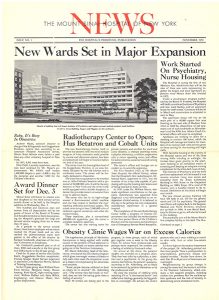
The first issue of The Mount Sinai Hospital News, which ran from 1958-1982
The Aufses Archives has many collections of newsletters. I am starting with the “Mount Sinai Hospital News.” The series consists of several large folders containing two sets of the title. The first newsletter set, set “one”, is known as the “preservation set.” As such, it isn’t handled frequently and contains the best copies. Set “two” contains the copies of the newsletter that are meant to be handled. This handling may occur when inquiries come in from several sources, including relatives of nursing school alumnae, providers previously employed by the hospital or medical school, and hospital or school departments sourcing historical projects, among others. Both sets are stored among the other contents preserved by the Archives.
The archives are not a museum, and so they contain mostly paper-based items and files pertaining to the history of the hospital and medical school. In addition to the collection of newsletters, the Archives includes photographs, meeting minutes, office files, and miscellanea. The collection does house selected objects, including some medical devices, dolls, and even a moulage kit from the 1990s recently passed along to the Emergency Department for use in emergency drills. One of the oldest objects, a ledger indicating notes from one of the first Mount Sinai Beth Israel board meetings, is written by hand in Yiddish and dates back to the 1890s.
The Plan
At the start of the project, the team discussed plans for indexing a collection of newsletters. Would we keep an Excel file of key terms, titles, and dates? Could we also digitize the newsletters? After thinking about the “what” that we would like to make available, we discussed the “how” and “why” of the project. How would the Archives’ online readership access tools to search the newsletter collection? Would we be able to leverage resources to make every issue available online? What were the costs and benefits of spending time uploading each issue digitally?
I was happy to volunteer my help with scanning the newsletters, due in part to my history with an old archive project at the Everson Museum of Art in Syracuse, NY. As a curatorial intern I had been dying to scan the museum’s collection of newspaper clippings highlighting exhibitions and visits by Yoko Ono and John Lennon among other fascinating historical happenings! As it happened, our crew in Syracuse was limited by resource shortages, and scanning would have to be pushed to the next summer.
After some thought and research into searchable PDF text formats, my inclination to scan and upload every issue into our database (then online) was accepted! I was carefully handed a small pile of newsletters, then headed into our neighboring IT office to commandeer the scanner for an hour. The process of scanning had begun!
Watch for Part II, coming soon.
Apr 17, 2017
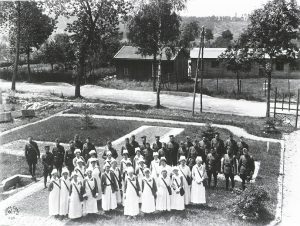
Nurses and doctors of St. Luke’s Hospital Evacuation Hospital No. 2
April 2017 is the 100th anniversary of the entry of the United States into World War I. Like many institutions in American society, the American hospital system and its doctors and nurses were rapidly mobilized to join the war that had been raging in Europe since the summer of 1914. The Mount Sinai Archives has now installed a display in the Annenberg Building north lobby outlining the activities of the hospitals in the Mount Sinai Health System.
In New York City, The Mount Sinai Hospital, St. Luke’s Hospital and The Roosevelt Hospital (today’s Mount Sinai West) all contributed to the war effort by establishing overseas units affiliated with their respective hospitals, and many doctors at Beth Israel Hospital volunteered individually. The records, photographs and correspondence on display in these cases reflect the experience of a war that defined a generation.
For the medical officers and administrators in charge of overseas hospital units, organizing effective hospital service on a scale never before seen was an immense logistical challenge. And for the individual doctors and nurses working with patients, who saw at close hand the terrible destruction inflicted by new methods of trench warfare and aerial combat, all while dealing with a world-wide pandemic of influenza, the war was an experience of medicine at its most fundamental, as they struggled under harsh conditions to relieve human suffering.
The items on display include images of the staff from the hospitals in their World War I roles; a scrapbook from Marion Moxham, a nurse from Ireland who joined with the Mount Sinai unit, Base Hospital No. 3; letters home from physicians to the Beth Israel Hospital administration; dog tags; a medal that was awarded to members of the Mount Sinai unit; images of the wounded and wards of St. Luke’s Evacuation Hospital no. 2 and a photo of the mascot of the Roosevelt Hospital group.
Jul 21, 2016
The Mount Sinai Archives has received a large amount of new archival material over the last year, well over 186 feet of paper, photographs, and (sometimes) disintegrating leather-bound volumes. The bulk of these new collections contain material from Mount Sinai St. Luke’s Hospital and Mount Sinai West (the former Roosevelt Hospital), but they also include items documenting the Beth Israel Medical Center, Mount Sinai Queens, The Mount Sinai Hospital and the Medical School. Organizing, preserving and making available such a great quantity of material is a complex and time-consuming task, but the effort is well worth it, because these collections include many important historic treasures. Those treasures are the theme for a new Archives’ display in the Annenberg Building lobby. Here are some highlights from the display.
What makes a historical document or artifact a ‘treasure’? Sometimes, historical records provide information on an important person or an institution. The 1854 Bible belonging to the Rev. Dr. William Muhlenberg, founder of St. Luke’s Hospital, is an example of that, as are the newsletters and Annual Reports of the various Mount Sinai Health System hospitals that we have received. Other times, an item can be a ‘treasure’ because it provides context for what life was like at a specific period of time, highlighting how things have changed, or perhaps showing how some things never change. The Fathers’ Book from the Woman’s Hospital in the early 1940s does that, as do the reports created by the Mount Sinai Environmental Sciences Laboratory that are displayed. And sometimes what makes an item a ‘treasure’ is just that there is something appealing, unique or unexpected about it. Who would think that the Mount Sinai Archives has a World War II era U.S. War Department issued Japanese phrase book, currently on display in the Nursing case below the Stern Auditorium stairs? It is part of the papers sent to us by the daughter of Esther Winkler Shapiro, Class of 1944.
Perhaps the most surprising treasure we found as we put this exhibit together were the photographs and documents tucked into the back of a scrapbook from the Roosevelt Hospital School of Nursing, which was formed in 1896 and closed in 1974. This scrapbook, wrapped in the traditional blue stripe of the Roosevelt uniform, was created by Evelyn I.V. Howard, Class of 1908. The last few pages of the book include photographs and notes from Nina Gage, RN, a classmate of Miss Howard’s. These pieces document Gage’s years at a Red Cross hospital at the Hunan-Yale School for Nurses in Changsha, China from 1908-1915. There are photos of the facility as well as students and faculty members.
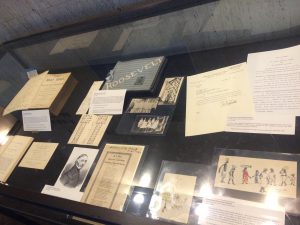
A view of one of the display cases showing Rev. Muhlenberg’s Bible in the far left corner and the Roosevelt nursing scrapbook in the middle.
If you are nearby, please stop in and take a look at our display. If you would like additional information, please contact us at msarchives@mssm.edu.
 The Woman’s Hospital, often considered the first hospital in this country dedicated to treating the diseases of women, opened on May 4, 1855 in a house on Madison Avenue. It was founded by the currently controversial J. Marion Sims, MD, pictured right, in concert with a group of influential New York City women. Sims arrived in New York in 1853 from his home in Alabama, where he developed a procedure to close vesicovaginal fistulas. He relocated to New York in hopes of improving his own chronic health condition.
The Woman’s Hospital, often considered the first hospital in this country dedicated to treating the diseases of women, opened on May 4, 1855 in a house on Madison Avenue. It was founded by the currently controversial J. Marion Sims, MD, pictured right, in concert with a group of influential New York City women. Sims arrived in New York in 1853 from his home in Alabama, where he developed a procedure to close vesicovaginal fistulas. He relocated to New York in hopes of improving his own chronic health condition. As mentioned above, the first Woman’s Hospital was a rented four-story brownstone at 83 Madison Avenue, off 29th Street, pictured left. The brownstone held forty beds and welcomed its first patient in May of 1855. The response to the Hospital’s opening was so great, by fall of 1855 that another surgeon, Thomas Addis Emmet, joined Dr. Sims as the second surgeon on staff. It wasn’t long before the Woman’s Hospital Board was seeking larger accommodations to meet patient demand.
As mentioned above, the first Woman’s Hospital was a rented four-story brownstone at 83 Madison Avenue, off 29th Street, pictured left. The brownstone held forty beds and welcomed its first patient in May of 1855. The response to the Hospital’s opening was so great, by fall of 1855 that another surgeon, Thomas Addis Emmet, joined Dr. Sims as the second surgeon on staff. It wasn’t long before the Woman’s Hospital Board was seeking larger accommodations to meet patient demand. Over the years, the Board recognized the need to develop additional services. A post-graduate school of nursing admitted its first class in 1888. The establishment of a hospital pharmacy in 1881, a maternity ward in 1910, and a social services department in 1912 are examples of the additional services made available at Woman’s Hospital.
Over the years, the Board recognized the need to develop additional services. A post-graduate school of nursing admitted its first class in 1888. The establishment of a hospital pharmacy in 1881, a maternity ward in 1910, and a social services department in 1912 are examples of the additional services made available at Woman’s Hospital. Hospital services resumed in 1906, when a newly constructed Woman’s Hospital opened on West 109th Street, between Amsterdam and Columbus Avenues, pictured left. The hospital functioned here until 1965, when it moved just a few blocks north into a newly constructed building on the St. Luke’s Hospital campus at Amsterdam Avenue at 114th Street, pictured right.
Hospital services resumed in 1906, when a newly constructed Woman’s Hospital opened on West 109th Street, between Amsterdam and Columbus Avenues, pictured left. The hospital functioned here until 1965, when it moved just a few blocks north into a newly constructed building on the St. Luke’s Hospital campus at Amsterdam Avenue at 114th Street, pictured right.






